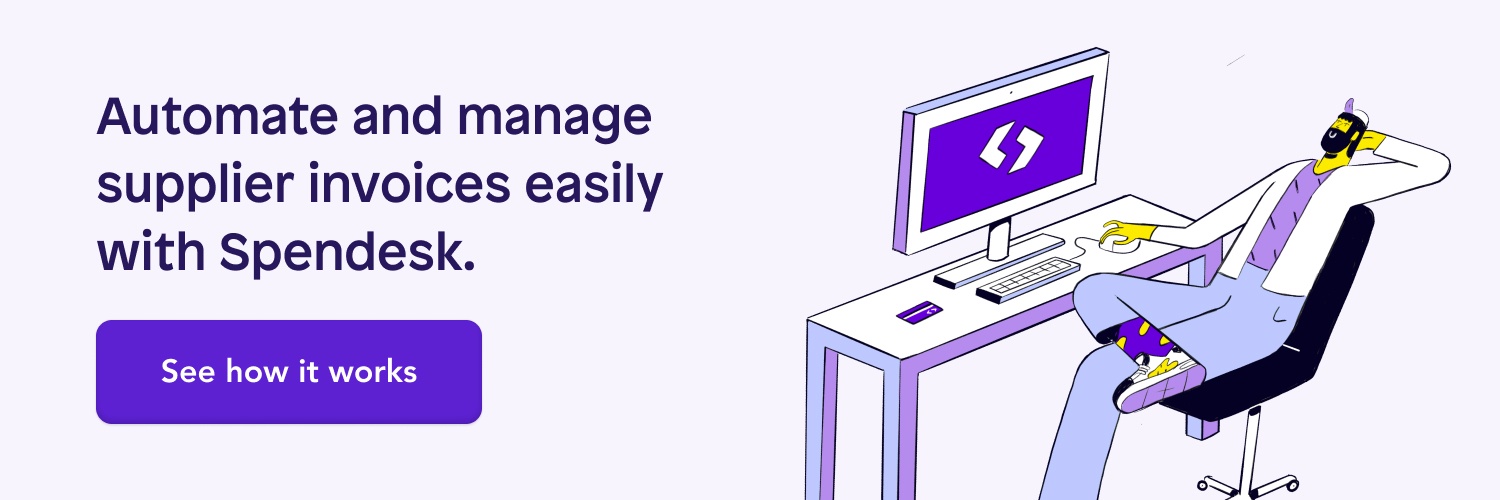)
We go on and on about the benefits of automation. And the concept is pretty simple: you take slow, repetitive processes that normally waste hours or days each month, and let smart software take care of them for you.
Nowhere is this more apparent than in finance teams. Accounting, expenses, and payment reconciliation are often still stuck using outdated processes and tools, with teams moving slower than they need to.
We can add accounts payable to that list, too. From purchase orders, to supplier invoices, to approvals and accounting, there are so many touchpoints that are still done manually. Which means long wait times to process invoices, and that can mean unhappy suppliers.
Most importantly, it means your expert team members are focused on basic, low-value tasks, and not working towards profitability and protecting the company’s balance sheet.
So in this post, we’re going to talk about automating much of accounts payable, and getting on with the more complex or important work for finance and purchasing departments.
What is accounts payable automation?
As the name suggests, accounts payable automation refers to tools or processes that eliminate manual aspects of accounts payable, and instead automate them. This usually involves a dedicated software, some examples of which we’ll examine shortly.
Specifically, AP automation lets you submit and approve purchase orders and invoices digitally, rather than dropping them physically in in-trays. Some solutions will read invoices and extract information themselves, which means no data entry for anyone on your team.
The goal for most process automation is to move faster, reduce errors, and help the company scale easily. And in the case of accounts payable, as Purchase Control explains, “this removes manual tasks while also providing improved visibility and control over important financial data.”
On top of those broad objectives, AP automation has several clear benefits.
The big benefits of an automated AP process
In most cases, automation just makes everyone’s life easier. But it’s still an investment (although one that can often pay for itself), so let’s look at why you should consider automation.
Implemented well, accounts payable automation:
Saves time. What was previously slow and repetitive work - checking purchase order forms, verifying payment terms, and entering data - is now done almost instantly.
Leads to fewer errors. Whereas humans tend to make mistakes the more manual a task is, computers repeat them endlessly without fault.
Sticks to the script. Internal controls like invoice approvals are important, but easily overlooked. An automated process ensures that every box is ticked correctly.
Digitises documents by default. Giant storage rooms and paper filing are out. Rather than filling out paper purchase orders then scanning and emailing them around the office, why not go digital right from the start?
Increases productivity. The upshot of saving such a large amount of time on boring, manual work, is that your teams have more time for the work they should be doing. That starts with the finance and/or AP department, of course, but includes other teams that don’t know how accounts payable works, and waste time figuring it out.
Makes AP accessible from anywhere. Paper processes usually need to be done in the right place. The payables department has an in-tray and a filing cabinet, and needs physical access to both. But cloud-based processes can be done from anywhere!
Gives autonomy to other teams. If you choose a well-made, intuitive AP automation tool, these processes become accessible to everyone - not just finance. Other teams can confidently file purchase orders quickly and efficiently, with a system that walks them through step by step. Which means they need a lot less hand-holding than they used to.
Optimises payment terms. Each vendor invoice has its own terms. Some require timely payments - within 15 days. Others give you months. Adeptly timing these short-term liabilities - and avoiding late payment penalties - lets you make the most of your working capital.
Of course, you’ll find plenty more benefits the longer you stick with a good AP software. Which brings us to the next section.
For those new to accounts payable automation, we present a few good options to help you manage the process easier than you’d previously imagined.
5 great tools for automating your accounts payable process
This is by no means an exhaustive list. Rather, we wanted to present a small range of good, different options, to show you the kinds of tools available and the problems they help solve.
Depending on your precise needs, one of these tools will likely solve it better than the others. So read through our list and see which of the following ticks the right boxes for your business.
1. Spendesk
Spendesk isn’t built just for accounts payable. It’s a comprehensive spend management solution that automates the worst aspects of expense reports, invoicing, and company credit cards.
The beauty of this is you have one platform for all your operational spending. Employees will quickly learn the right way to claim expenses, to pay for things while travelling, to request new subscription tools, and to pay consultants and freelancers for their services.
Finance teams can track budget metrics, accruals and current liabilities, while payables managers have the tools they need to manage operations.
Handle all of these processes with essentially the same workflow - and using the same platform.
Key benefits
Keep all forms of purchasing in one tool, meaning less individual training and fast improvements.
OCR software to scan invoices automatically and input their data.
Let individual employees manage their own purchases, rather than coming to the finance or procurement team every time.
Set specific spending limits per team or user, and track all managerial approvals without effort.
Verify and store every proof of purchase within the platform, from the moment a transaction is made.
Automatically assign payables to the correct expense account and general ledger code.
User quote: “I can submit an invoice via email, on the mobile phone or through the web app. This has helped me own my budget with total independence and transparency. When I upload an invoice, Spendesk can read the amount, date, supplier, etc, so I no longer hate reporting expenses!”
2. Quadient
AP Automation by Quadient is a tool designed for accounting teams. The tool automates invoicing and reporting and is very helpful for companies going through an audit (see user quote below).
Of course, the reason it works so well for accountants is that it’s easy to use for employees with all levels of financial knowledge and technical know-how. So the finance team receives well-formatted requests and can push data into accounting tools with minimal manipulation.
Key benefits
Imports and scans invoices automatically.
Centrally stores important AP documents, including purchase orders and invoices.
It matches invoices to purchase orders automatically.
Includes workflows to require and track approvals from managers.
User quote: “Streamlined our approval process and even allows multiple staff to approve. We use it for 99 percent of invoices. And it really saved a lot of staff time preparing for our annual audit because we just gave the auditors access to the whole AP system. Don't know how I lived without it!”
3. Gatekeeper
Gatekeeper is a “vendor & contract lifecycle management (VCLM) platform” for everyone from the CFO and finance teams to sales and legal departments. It’s great for companies dealing with lots of contracts, particularly with regular vendors.
One of the most interesting features is the dedicated Vendor Portal. This lets you give regular vendors access to (a limited version of) the tool, featuring your branding. They can upload invoices and update purchase orders themselves, saving both parties time and effort.
Agile teams will also enjoy the Kanban Workflow Engine, which lets your whole team see who is responsible for each step of the process.
Key benefits
Vendors can create their own invoices within the system via the Vendor Portal. So no need to scan or forward invoices amongst your team members.
Additional documents can be attached to contracts, such as images, invoices, and memos.
Approvals are integrated within the system, which streamlines the process and cuts down on unnecessary communication.
Gatekeeper integrates with CRM software to link contracts with other customer records.
User quote: “Ideal system with feature set matches our needs. I like workflow flexibility, access control, bulk upload/update, flexible vendor and contract views, user management and dashboards.”
4. Stampli
Stampli automates invoice processing similar to Spendesk, but without the other payment tools like company cards and expense automation. Contractors and suppliers send in their invoices, and your team members simply feed them into the system for approval and processing.
This process gets faster and faster thanks to Billy, a bot that reads your invoices and extracts key details. Billy learns more as time goes by, which makes coding invoices easier the more you use the tool.
Stampli also has a supplier portal, so trusted vendors can also submit invoices directly into the system. But the most popular aspect of the tool is its approval workflows, which satisfies 96% of reviewers.
Key features
Billy the Bot scans invoices and extracts the data.
Approvers can see all their outstanding invoices in one place.
Digitises invoices from the beginning.
Integrates well with accounting and other financial software.
User quote: “We have gone from paperclips, mass amounts of paper, and staples to no paper invoices, no filing, and no wasted time with paper, period! Each of the people who handle A/P can work at their own pace and are not dependent on others to get their work done like it was in the past.”
5. Mimo
For UK small businesses, Mimo is an intriguing option. Short for “money in, money out,” the platform helps you take full control over working capital.
At first blush, the tool automates the invoice payment process. You upload invoices and pay directly from the platform, which means there’s no end-of-month reconciliation to worry about.
Where it gets more interesting is with Mimo’s lines of credit. These short-term debt facilities let business owners purchase raw materials and make other necessary supplier payments before they’ve collected accounts receivable. In other words, you can send money out before money comes in.
Key features
Pay invoices in bulk, directly from the platform. No bank run required.
Hold multiple currencies for international suppliers.
Open a short-term credit line to pay quickly without impacting cash flow.
Set up flows to ensure that every payment is approved in advance.
Integrates with key bookkeeping tools like Sage, Xero, and QuickBooks.
Automate your accounts payable process ASAP
Hopefully the tools mentioned above inspire you to automate your accounts payable process right away! Adopting an automated AP tool is a worthwhile change to make.
Slow, manual processes should be a thing of the past. Smart businesses already know how much more productive and efficient their teams become once they automate the repetitive, time consuming parts of the day to day.
And accounts payable is a rich hunting ground for processes to upgrade. For decades, companies have relied on paper purchase orders, paper approvals, and paper filing systems to run a working invoicing system. It’s time to move away from all that paper.
Automated systems are almost always:
Faster
Easier to understand
Less error-prone
Cheaper in the long run
The only thing left to do is to take a few of these tools for a test run.




)
)
)
)
)